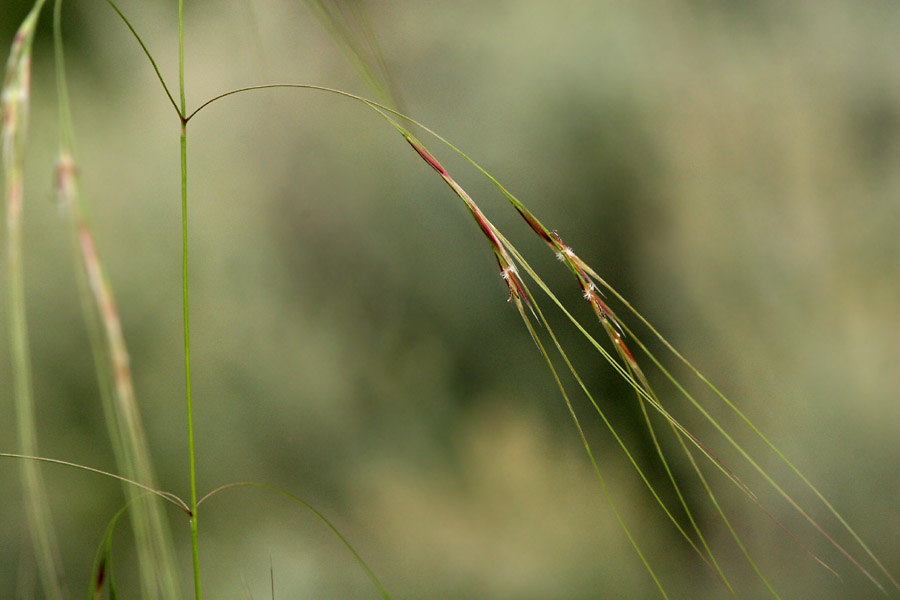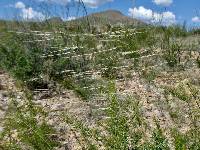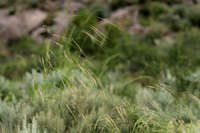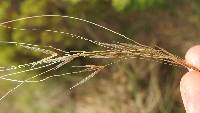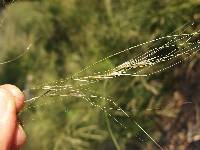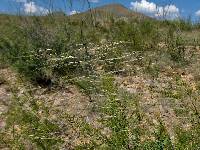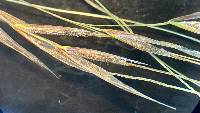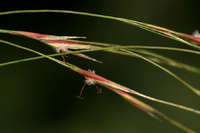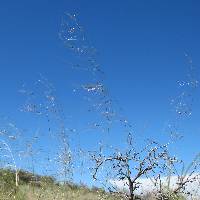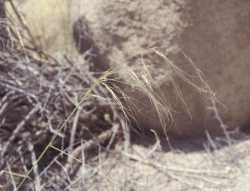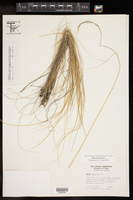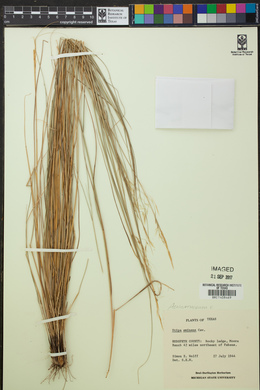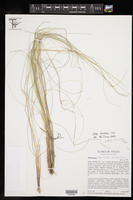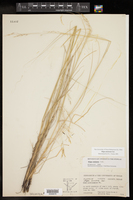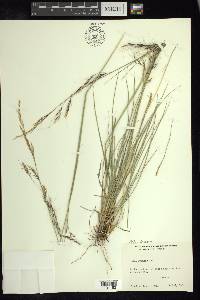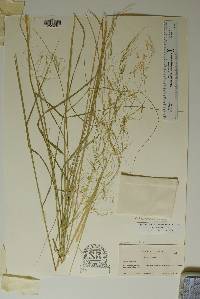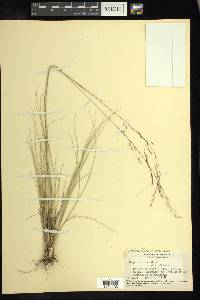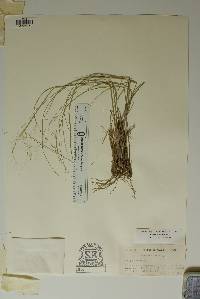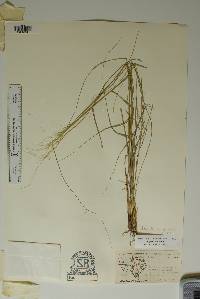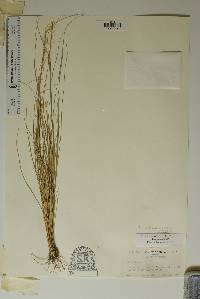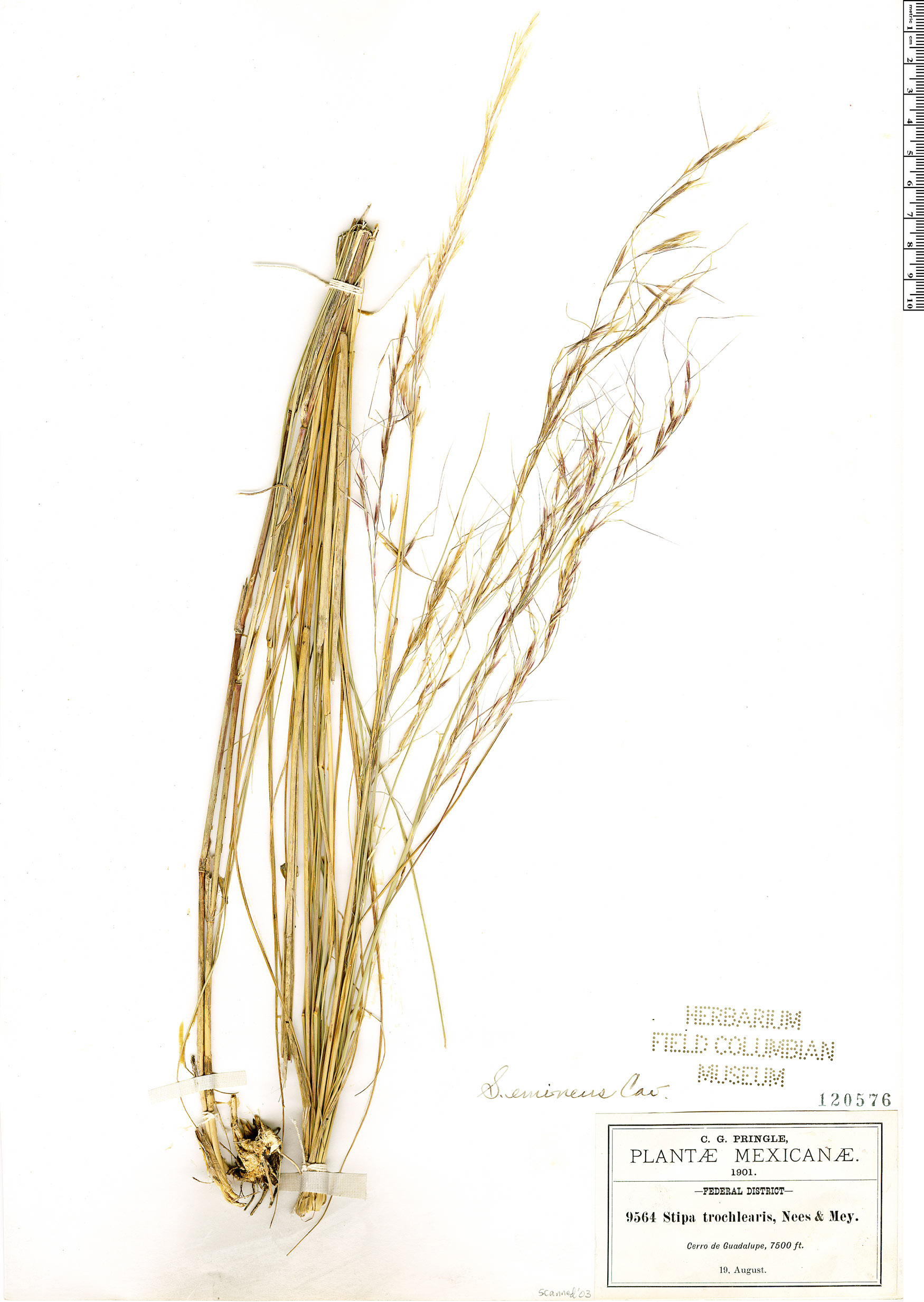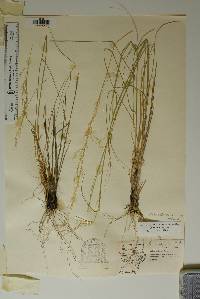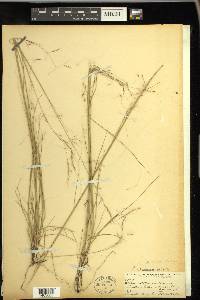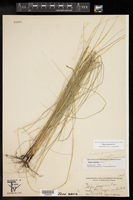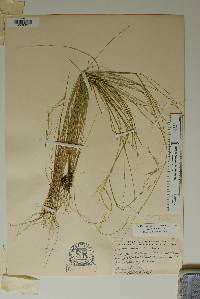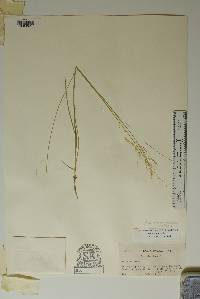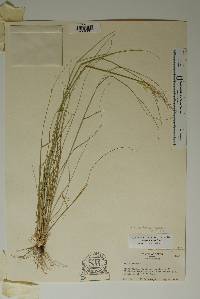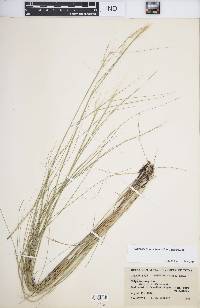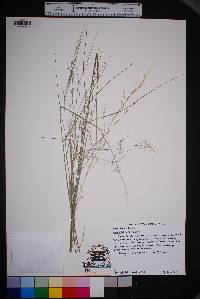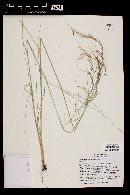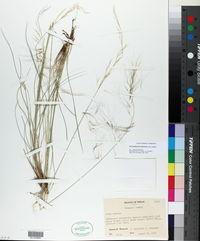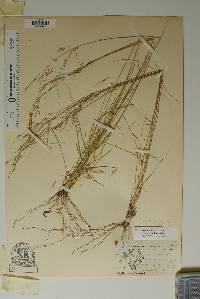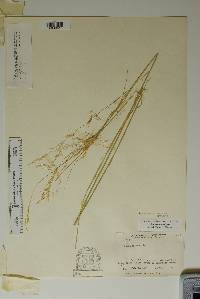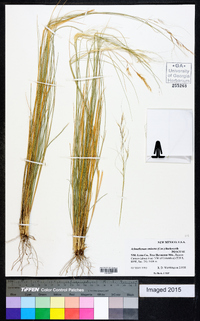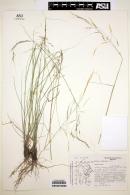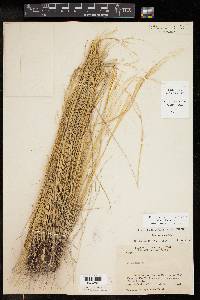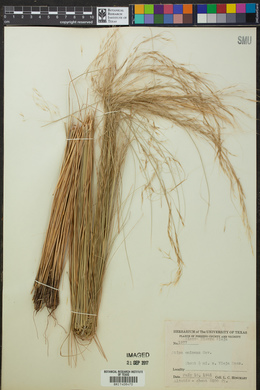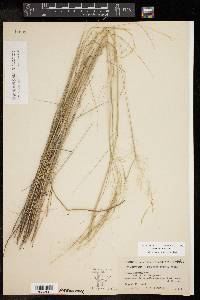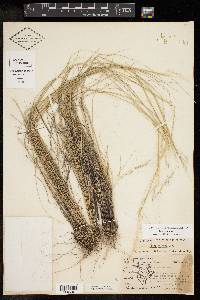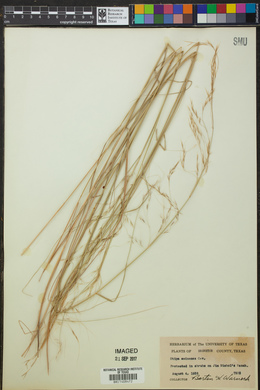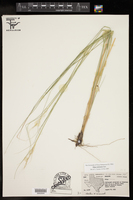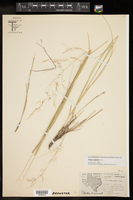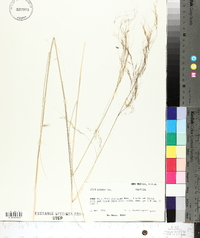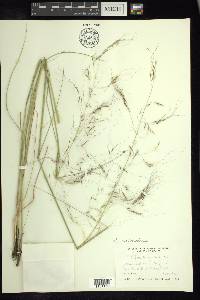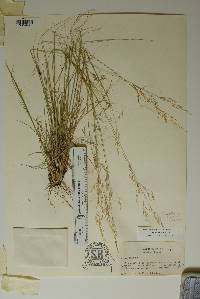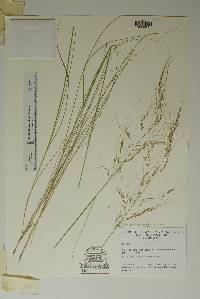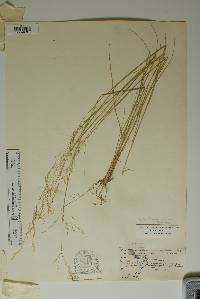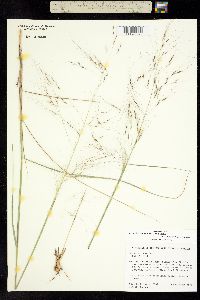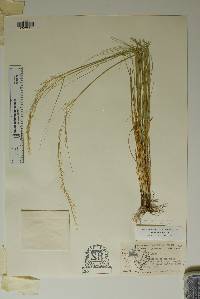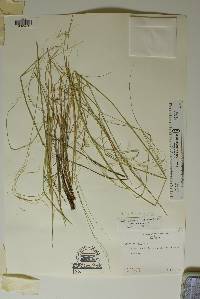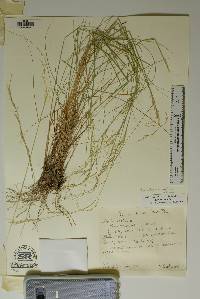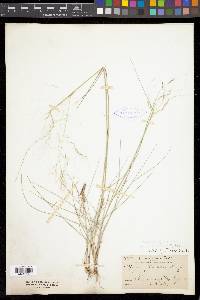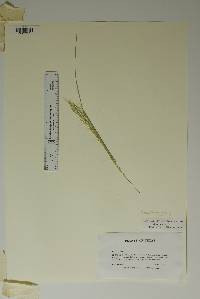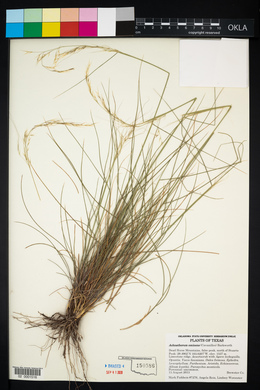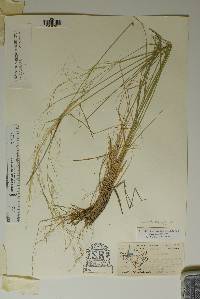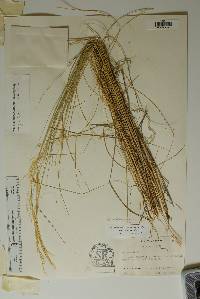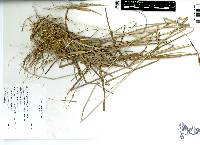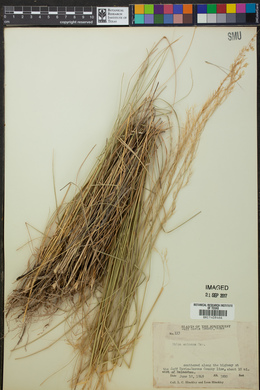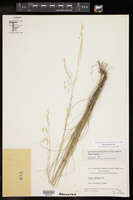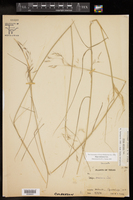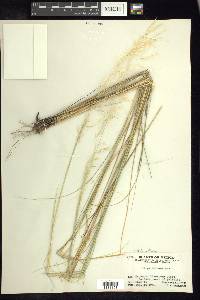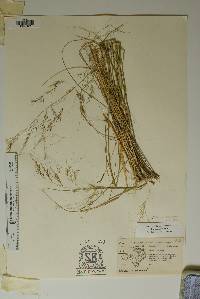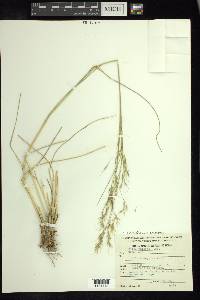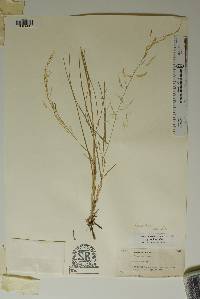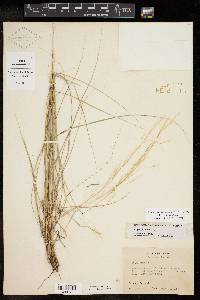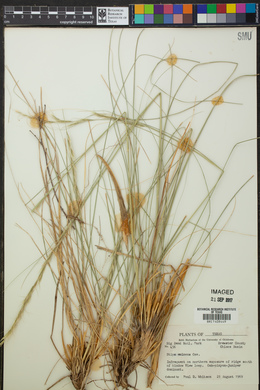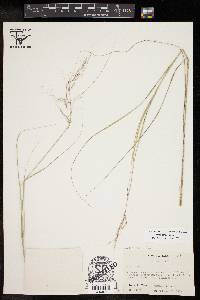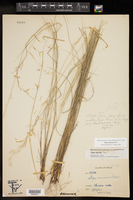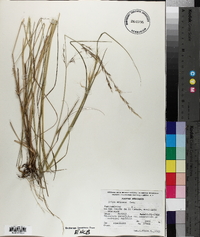
|
|
|
|
Family: Poaceae
southwestern needlegrass, more...Southwestern Rice Grass
[Stipa eminens Cav., moreStipa erecta E. Fourn.] |
Plants cespitose, shortly rhi-zomatous, bases knotty. Culms 50-100 cm tall, 0.8-1.5 mm thick, glabrous; nodes 2-3. Basal sheaths mostly glabrous, ciliate on the margins; collars glabrous on the back, usually with tufts of hair on the sides, hairs about 0.8 mm; basal ligules 0.8-1.6 mm, membranous, glabrous, rounded to acute; upper ligules to 4.5 mm, acute; blades 0.7-3.5 mm wide, abaxial surfaces smooth to scabridulous, adaxial surfaces prominently ribbed, scabridulous or sparsely to densely pubescent, hairs about 0.1 mm. Panicles 20-55 cm long, 3-8 cm wide, open, often enclosed to midlength at anthesis; lower branches 5-8 cm, ascending to divergent, flexuous. Lower glumes 5-12 mm long, 0.5-0.7 mm wide, 3-5-veined; upper glumes 1-4 mm shorter, 3-veined; florets 4-7.5 mm long, 0.5-0.9 mm thick, fusiform, terete; calluses 1-2 mm, sharp; lemmas evenly hairy, hairs 0.4-0.8 mm throughout, apical lobes not present; awns 35-70 mm, persistent, twice-geniculate, first 2 segments scabrous, terminal segment flexuous; paleas 1-2 mm, 1/3-1/2 as long as the lemmas, sparsely to moderately pubescent, apices rounded, flat; anthers 3-3.5 mm, dehiscent, a few penicillate, hairs about 0.3 mm. Caryopses about 4 mm, fusiform. 2n = 44, 46. Achnatherum eminens grows on dry, rocky slopes and valleys in the mountains of the southwestern United States, primarily in desert scrub, at 600-2600 m. Its range extends into Mexico. It is easy to recognize because of its open panicle, flexuous branches, and flexuous awns. It is superficially similar to Nassella cernua, but differs in its longer, glabrous ligules, not or weakly overlapping lemma margins, pubescent paleas, and geographic distribution. Dr. David Bogler, USDA NRCS PLANTS Database Perennials, Terrestrial, not aquatic, Stems nodes swollen or brittle, Stems erect or ascending, Stems caespitose, tufted, or clustered, Stems terete, round in cross section, or polygonal, Stem internodes hollow, Stems with inflorescence less than 1 m tall, Stems with inflorescence 1-2 m tall, Stems, culms, or scapes exceeding basal leaves, Leaves mostly basal, below middle of stem, Leaves mostly cauline, Leaves conspicuously 2-ranked, distichous, Leaves sheathing at base, Leaf sheath mostly open, or loose, Leaf sheath smooth, glabrous, Leaf sheath and blade differentiated, Leaf blades linear, Leaf blades very narrow or filiform, less than 2 mm wide, Leaf blades mostly flat, Leaf blade margins folded, involute, or conduplicate, Leaf blades mostly glabrous, Ligule present, Ligule an unfringed eciliate membrane, Inflorescence terminal, Inflorescence an open panicle, openly paniculate, branches spreading, Inflorescence solitary, with 1 spike, fascicle, glomerule, head, or cluster per stem or culm, Inflorescence lax, widely spreading, branches drooping, pendulous, Inflorescence curved, twisted or nodding, Flowers bisexual, Spikelets pedicellate, Spikelets dorsally compressed or terete, Spikelet less than 3 mm wide, Spikelets with 1 fertile floret, Spikelets solitary at rachis nodes, Spikelets all alike and fertille, Spikelets bisexual, Spikelets disarticulating above the glumes, glumes persistent, Spikelets disarticulating beneath or between the florets, Rachilla or pedicel glabrous, Glumes present, empty bracts, Glumes 2 clearly present, Glumes equal or subequal, Glumes equal to or longer than adjacent lemma, Glumes 3 nerved, Lemma 5-7 nerved, Lemma body or surface hairy, Lemma apex acute or acuminate, Lemma distinctly awned, more than 2-3 mm, Lemma with 1 awn, Lemma awn 2-4 cm long or longer, Lemma awned from tip, Lemma awn twisted, spirally coiled at base, like a corkscrew, Lemma awn once geniculate, bent once, Lemma awn twice geniculate, bent twice, Lemma margins inrolled, tightly covering palea and caryopsis, Lemma straight, Callus or base of lemma evidently hairy, Callus hairs shorter than lemma, Palea present, well developed, Palea membranous, hyaline, Palea shorter than lemma, Stamens 3, Styles 2-fid, deeply 2-branched, Stigmas 2, Fruit - caryopsis, Caryopsis ellipsoid, longitudinally grooved, hilum long-linear.
FNA 2007, Gould 1980 Common Name: southwestern needlegrass Duration: Perennial Nativity: Native Lifeform: Graminoid General: Perennial plants tufted, shortly rhizomatous, knotty bases; stems 50-100 cm tall, strictly erect. Vegetative: Sheaths glabrous, ciliate on margins, collars with tufts of hair on the sides, hairs about 1 mm; basal ligules 0.5-1.5 mm, membranous, glabrous, rounded to acute, upper ligules to 4.5 mm, acute; blades 0.5-3.5 mm wide, flat to involute, lower surfaces smo Inflorescence: Panicles 20-55 cm long, 3-8 cm wide, open, enclosed to midlength at anthesis, flexuous; lower branches 5-8 cm, ascending to divergent, flexuous; lower glumes 5-12 mm long, 3-5 veined; upper glumes 1-4 mm shorter, 3-veined; florets 4-7.5 mm long, 0.5-1 mm thick, terete; lemmas evenly hairy, hairs minute, apical lobes not present; awns 35-70 mm, persistent, twice-geniculate, first 2 segments scabrous, terminal segment flexuous; paleas 1-2 mm, half to third as long as lemmas, moderately pubescent, apices rounded to flat. Ecology: Found on dry slopes, often on rocky soils from 2,000-8,500 ft (610-2591 m); flowers August-October. Distribution: se AZ, s NM, sw TX; south to c MEX. Notes: Distinguished by an open panicle, single floret spikelets (single seeded spikelets) with long awns 30-70 mm which are often bent or corkscrewed in two turns (twice geniculate). Look for plants often growing from beneath other plants and sticking up above shrubs and other vegetation to over a meter tall with large, open panicles with wispy, long awns. Ethnobotany: Unknown, but other species in the genera were eaten. Etymology: Achnatherum comes from the Greek achne, for chaff or glume and ather for stalk or barb, so stalked or barbed lemma, while eminens means projecting or eminent. Synonyms: Stipa eminens Editor: SBuckley 2010, FSCoburn 2014 |
|
|
|

